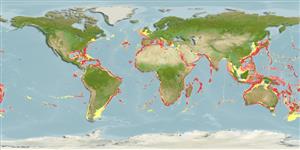Common names from other countries
Classification / Names / Names
Namen | Synonyme | Catalog of Fishes (gen., sp.) | ITIS | CoL | WoRMS
Environment: milieu / climate zone / depth range / distribution range
Ökologie
Benthopelagisch; tiefenbereich 60 - 1300 m (Ref. 97594), usually 250 - 750 m (Ref. 409). Tropical; ? - 14°C (Ref. 434), preferred 20°C (Ref. 107945); 55°N - 55°S, 180°W - 180°E
Atlantic, the Mediterranean and Indo-Pacific. Tropical to temperate.
Length at first maturity / Size / Gewicht / Alter
Maturity: Lm 3.7, range 3 - 4.414 cm Max length : 17.0 cm TL Männchen/unbestimmt; (Ref. 104052); 22.5 cm TL (female); max. veröff. Gewicht: 45.90 g (Ref. 126095); max. veröff. Gewicht: 45.90 g; max. veröff. Alter: 8 Jahre (Ref. 80203)
Deep-water benthopelagic shrimp (Ref. 114287). Common total length: 12 to 16 cm. Minimum common depth from Ref. 8. Usually caught on muddy and sandy bottoms of continental slopes (Ref. 434). Lives on bottom mud (Ref. 8); also on sandy bottoms. Moves to midwater at night (Ref. 409). Carnivorous, feeds mainly on euphausiids and other species of crustaceans, i.e., mainly Natantia sp. (Ref. 434). Has a highly diversified diet (Refs. 97770, 105137), preying on pelagic, benthic and benthopelagic organisms (Ref. 105137); mainly forages on crustaceans and fish. Also scavenges upon carcasses of fish and cephalopods on the bottom (Ref. 97770). Exhibits cannibalism. Values of δ15N ranges from 6.68 and 7.96 in females, and 7.05 and 8.26 in males, with females having higher δ15N with increasing size (Ref. 105135).
Spawning occurs during spring to summer. Females have a life span of 7-8 years while males live for 5-6 years.
Pérez Farfante, I. and B. Kensley. 1997. (Ref. 75620)
IUCN Rote Liste Status (Ref. 130435)
CITES Status (Ref. 108899)
Not Evaluated
Not Evaluated
Nutzung durch Menschen
Fischereien: kommerziell
FAO - Fischereien: landings | FishSource | Sea Around Us
Tools
Internet Quellen
Estimates based on models
Preferred temperature
(Ref.
115969): 5.9 - 15.7, mean 10 (based on 1552 cells).
Widerstandsfähigkeit
hoch, Verdopplung der Population dauert weniger als 15 Monate. (K=0.37-0.96; tm=1.5; tmax=8).
Prior r = 0.77, 95% CL = 0.51 - 1.16, Based on 4 full stock assessments.
Verwundbarkeit
Low vulnerability (10 of 100).
